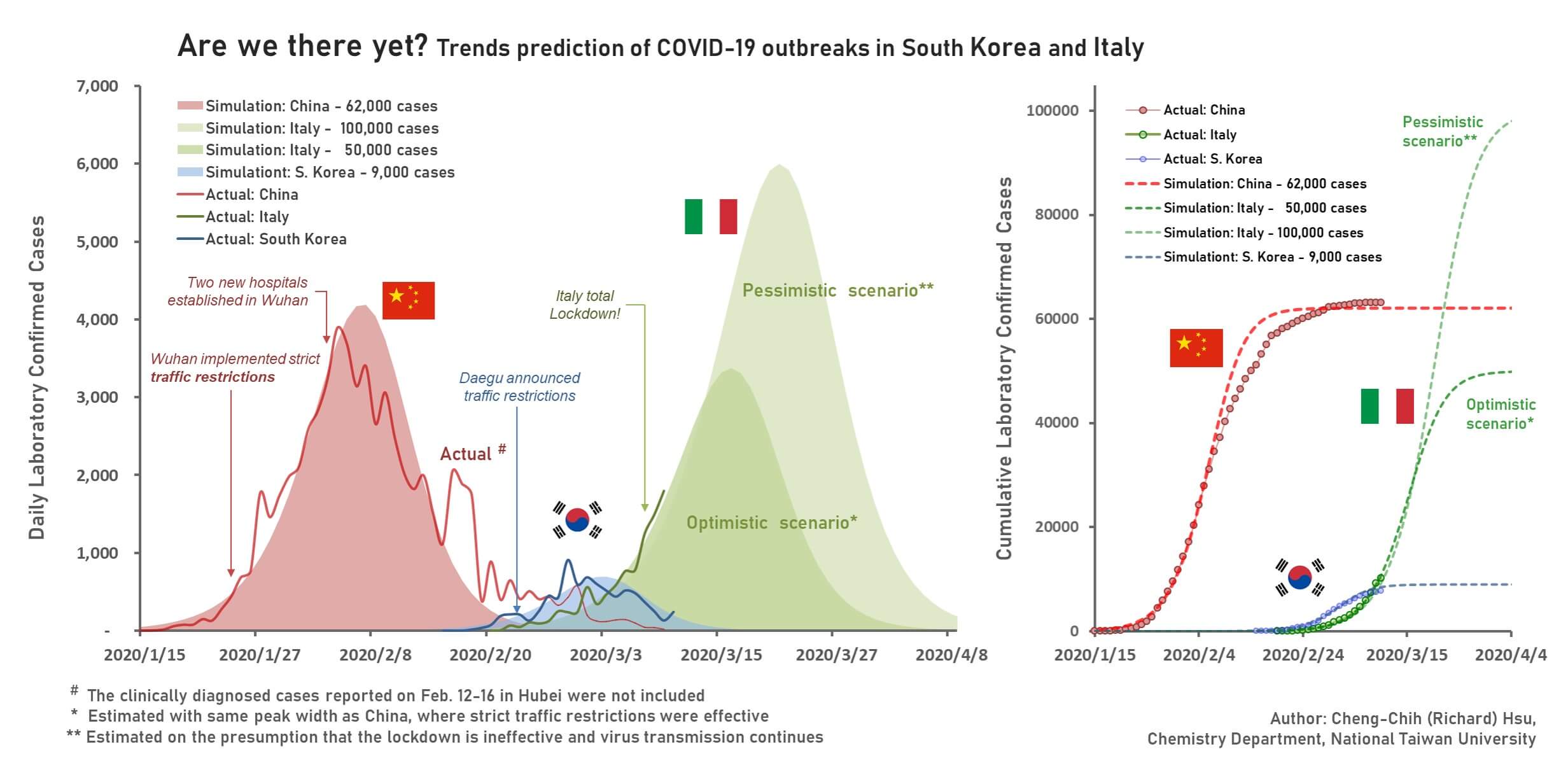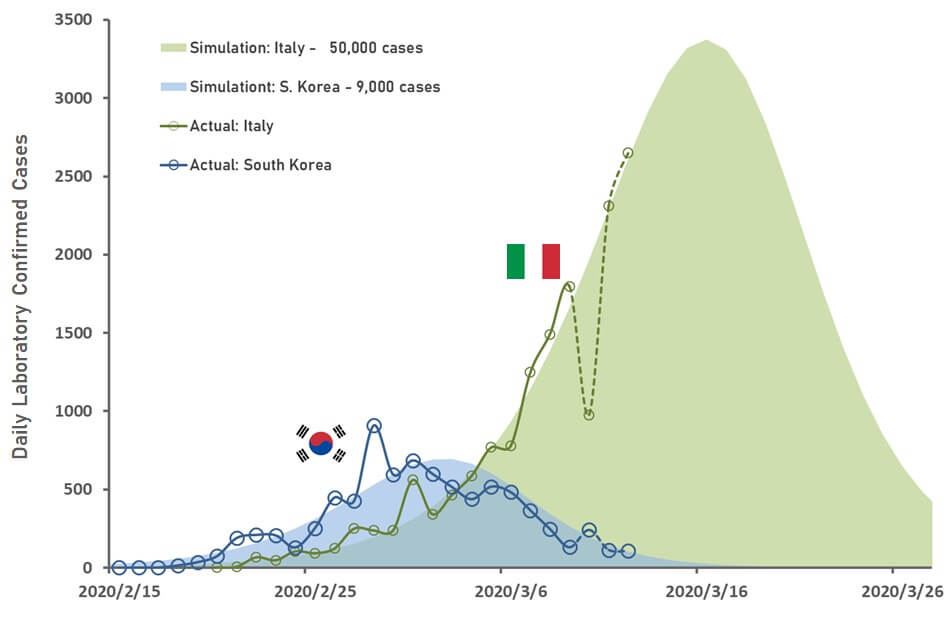Prediction of the COVID-19 Outbreak in South Korea and Italy
By Dr. Cheng-Chih (Richard) Hsu, Department of Chemistry, National Taiwan University
Methods:
The kinetic model was used to simplify the SIR model in epidemiology into: S (susceptible) + I (infected) →2I. The simulation was performed to predict the daily new confirmed cases in Korea and Italy (Figure 1 ), And a cumulative total of confirmed cases (Figure 2).
1. South Korea
Depending on preliminary results, there is a certain degree of chance that there will be no significant new confirmed cases before the end of March, but the total confirmed cases will not be zero. The final confirmed cases will be within 10,000 people (the model curve is estimated at 9,000 people). As long as other major cities in South Korea do not have large outbreaks, it should be possible to gradually reduce the number of new cases to close to zero in late March.
Notably, South Korea has not enforced lockdown similar to Wuhan. It only limits large gatherings and can effectively prevent outbreaks. As novel Coronavirus outbreaks continue to spike Europe and the United States, South Korea’s experience will be a means of preventing the outbreak.
Besides, the peak period of the outbreak in South Korea (about 12 days) is slightly shorter than Wuhan (about 18 days). It speculates that there are two main reasons: 1. The amount of medical care in South Korea is affordable. Most confirmed patients can receive quarantine treatment in the hospital; 2. South Korea expands laboratory testing capacity and conducts comprehensive screening for all possibly infected, which can quickly reduce the waiting time for the testing and can be screened at the earliest time isolate the infected person.
Utilizing the high-precision and high-throughput laboratory testing technology, coupled with effective isolation measures, can be applied to combat new infectious diseases in today’s urbanized cities.

2. Italy
The rate of increase of confirmed cases in Italy has already crossed with South Korea last week, towards Hubei. Based on the conditions in Hubei and South Korea, two boundary conditions are set to infer the possible final confirmed cases.
The first optimistic scenario is to assume that Italy’s lockdown and strict traffic restrictions started this week has achieved certain results. Based on the peak value of 12 days (similar to the situation in South Korea), the estimated number of final confirmed cases is 50,000. The highest peak for a single day of confirmed cases appears on March 16 and at the peak, approximately 3,000 people are diagnosed each day (assuming that there is enough testing capacity). The daily increase will gradually stop increasing from the beginning of April.
The first optimistic scenario is to assume that Italy’s lockdown and strict traffic restrictions starting this week will achieve outbreak prevention. Based on the peak value of 12 days (similar to the situation in South Korea), the estimated number of final confirmed cases will be 50,000. The highest peak for a single day of confirmed cases appears on March 16 and approximately 3,000 people are confirmed each day (assuming that there is enough lab capacity for the tests). Daily new cases will gradually decrease from the beginning of April.
The second is the pessimistic scenario, which is similar to the situation in Hubei. The epidemic area reached its peak about two weeks after the city was fully closed. In this forecast curve, the highest peak appears in the days around March 22, and the number of new confirmed cases in a single day will reach 6,000, the total confirmed cases will be 100,000, and the number of new confirmed cases will increase by the middle of April.
In the second pessimistic scenario, the total number of confirmed cases will be reached 100,000 in Italy finally, which is higher than the total number of confirmed cases in China. We have learned from the outbreak in China than in the core area of a large-scale outbreak, the upper limit of the number of confirmed cases is determined by the test capacity. The population of Italy is nearly the same as that of Hubei Province. Therefore, unless neighboring EU countries assist Italy in testing capacity, it is very difficult for Italy to have the confirmed cases like nearly 4000 people a day at the peak of China.
If the confirmed cases do not reach the expected peak, this does not mean that the epidemic is not serious, which is limited by current technologies causing hardly to see the whole picture, making it impossible to make operational strategies.

Conclusion
Using the simplified SIR model, we can predict the trend of the outbreak in South Korea and Italy by fitting the currently reported numbers of daily confirmed cases. In South Korea, the confirmed cases may cease to increase by the end of March, with a total of 9,000 confirmed cases. This is probably due to the instantaneous responses of Korean government to the outbreak, especially by providing a large capacity of laboratory tests. However, on the other hand, Italy is becoming another Hubei Province of China. The predictive curves show a total of 50,000 to 100,000 confirmed cases before the outbreak comes to an end in April. In the optimistic scenario, the peak of the daily confirmed cases can be as high as 3,000; whereas in the pessimistic scenario, the daily number is 6,000.
(Translated from Dr. Hsu’s post on Facebook )
Related Article: Understanding the Scientific Challenges in Combating the New Coronavirus
References
- The Economist: A Ray of Hope in the coronavirus curves, https://www.economist.com/graphic-detail/2020/02/12/a-ray-of-hope-in-the-coronavirus-curve?fbclid=IwAR2KPCywaAtBxFW9zpQDyW7Vuh6C10EUp7D2-Z-5XWeQCZ7OP4azcpbh6ww
- Compartmental models in epidemiology, Wikipedia, https://en.wikipedia.org/wiki/Compartmental_models_in_epidemiology?fbclid=IwAR2ceHSXggVXkHLPXjZ30xxaO9FHrWwmhWr4he4DyIk03P_oYpgNbgfltMQ
- KCDC, https://www.cdc.go.kr/board/board.es?mid=a30402000000&bid=0030&fbclid=IwAR3MJxDDBkwI8SyAA8zyzFJdxI8t0e2sUMlEGds7z0dmp6_EkPJxaPJ9C58
- Italy Department of Civil Protection, http://www.protezionecivile.gov.it/web/guest/media-comunicazione/comunicati-stampa?fbclid=IwAR0z6ZzA7ReZy0SaOgOBeRrtRdM9RCvCyqrFy4HHxWXfusoE6JQF67TW9Q4
- 科學月刊》2019冠狀病毒病何時結束?以動力學模型估算「疫情結束日」, https://www.scimonth.com.tw/tw/article/show.aspx?num=3733&page=1&fbclid=IwAR2yO262vdVJaqh87tEg2JUU1WBvJ_pjieG_O_5DiPvesrYN_vcDdL7c4FE
©www.geneonline.com All rights reserved. Collaborate with us: service@geneonlineasia.com









